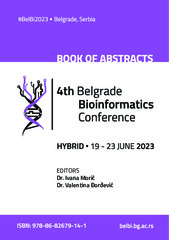Приказ основних података о документу
Metagenomic Analysis of Bacterial Community and Isolation of Representative Strains from Vranjska Banja Hot Spring, Serbia
| dc.contributor | Morić, Ivana | |
| dc.contributor | Đorđević, Valentina | |
| dc.creator | Curčić, Jovana | |
| dc.creator | Matijasević, Danka | |
| dc.creator | Stanisavljević, Nemanja | |
| dc.creator | Tasić, Srđan | |
| dc.creator | Kojić, Milan | |
| dc.creator | Malešević, Milka | |
| dc.date.accessioned | 2023-08-14T09:50:03Z | |
| dc.date.available | 2023-08-14T09:50:03Z | |
| dc.date.issued | 2023 | |
| dc.identifier.isbn | 978-86-82679-14-1 | |
| dc.identifier.uri | https://belbi.bg.ac.rs/ | |
| dc.identifier.uri | https://imagine.imgge.bg.ac.rs/handle/123456789/2057 | |
| dc.description.abstract | Thermal springs represent a habitat with extreme conditions that harbor a unique microbial community adapted to thrive in this environment. In addition to the geothermal springs in Iceland, the thermal springs of Vranjska Banja are considered the hottest in Europe with a water temperature of 63-95°C. Due to global warming and climate change, there is a growing need for knowledge about the biodiversity of extreme natural habitats. Besides the exceptional importance of studying extremophilic microorganisms, the difficulty in their cultivation limits the expanding necessity of research in this field. This study provides information about the microbial community structure and physicochemical characteristics of the thermal spring of Vranjska Banja. To determine and monitor the microbiota diversity of the Vranjska Banja hot spring, for the first time, comprehensive culture-independent metagenomic analysis in parallel with a culture-dependent approach was applied. The culture-independent composition of bacterial communities of the thermal water was investigated using MiSeq-Illumina technology and analyzed by the computing environment QIIME2 v2021. The applied cultivation approach resulted in the isolation of 17 strains belonging to genera Bacillus, Anoxybacillus, Hydrogenophilus, and Geobacillus, based on 16S rRNA sequencing and whole genome sequencing of five representative strains has been performed. The complete DNA was sequenced using Illumina HiSeq from the MicrobesNG service. Genomic characterization and OrthoANI analysis have shown that two of them are candidates for novel species. Products of extremophilic microorganisms adapted to harsh conditions have great potential to be used for biotechnological research and industrial application. Results of BAGEL4 and AntiSMASH showed that the sequenced strains from Vranjska Banja hot spring have the potential to produce thermostable enzymes (proteases, lipases, amylases, phytase, chitinase, and glucanase) and various antimicrobial molecules. | sr |
| dc.language.iso | en | sr |
| dc.publisher | Belgrade : Institute of molecular genetics and genetic engineering | sr |
| dc.rights | openAccess | sr |
| dc.source | 4th Belgrade Bioinformatics Conference | sr |
| dc.subject | 16S rRNA Metagenomic analysis | sr |
| dc.subject | genome analysis | sr |
| dc.subject | thermophilic bacterial diversity | sr |
| dc.subject | hot spring | sr |
| dc.subject | enzymatic potential | sr |
| dc.subject | antimicrobial molecules | sr |
| dc.title | Metagenomic Analysis of Bacterial Community and Isolation of Representative Strains from Vranjska Banja Hot Spring, Serbia | sr |
| dc.type | conferenceObject | sr |
| dc.rights.license | ARR | sr |
| dc.rights.holder | © 2023 Institute of Molecular Genetics and Genetic Engineering, University of Belgrade | sr |
| dc.citation.epage | 112 | |
| dc.citation.spage | 112 | |
| dc.citation.volume | 4 | |
| dc.description.other | Book of abstract: 4th Belgrade Bioinformatics Conference, June 19-23, 2023 | sr |
| dc.identifier.fulltext | https://imagine.imgge.bg.ac.rs/bitstream/id/321334/BELBI-Abstracts-final-07072023_1-15,128,129.pdf | |
| dc.identifier.rcub | https://hdl.handle.net/21.15107/rcub_imagine_2057 | |
| dc.type.version | publishedVersion | sr |

